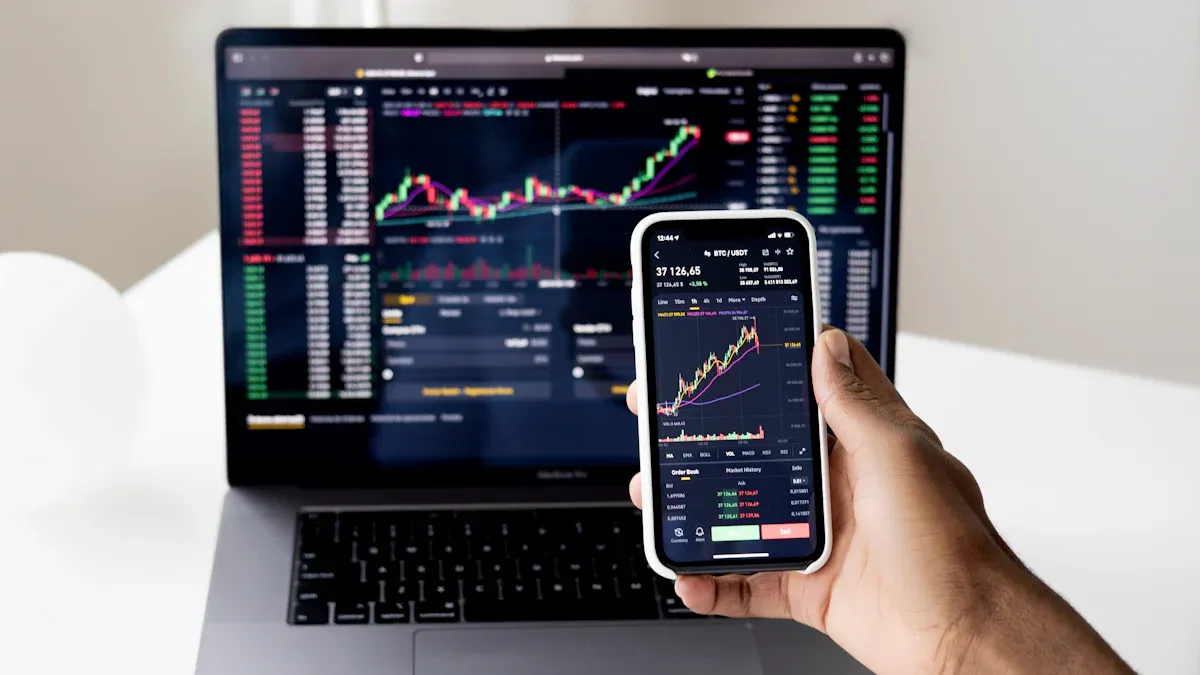- EasyCard
- Trade
- Help
- Announcement
- Academy
- SWIFT Code
- Iban Number
- Referral
- Customer Service
- Blog
- Creator
How U.S. Stock Market Opening Hours Help Investors Seize Opportunities

Image Source: pexels
Understanding U.S. stock market opening hours can help you more effectively seize investment opportunities. Each trading session has distinct market characteristics, from the active volatility at the opening to the stable trends before the close. Once you are familiar with these characteristics, you can more flexibly respond to market changes and develop more precise trading strategies. This not only enhances your investment efficiency but also effectively reduces unnecessary risks. Mastering the details of trading hours is crucial for improving your investment returns.
U.S. Stock Market Opening Hours and Their Importance

Image Source: pexels
Definition and Scope of U.S. Standard Trading Hours
The standard trading hours of the U.S. stock market are the primary periods for investors to conduct trades. Based on Eastern Time (ET), standard trading hours run from 9:30 AM to 4:00 PM. During this period, market trading activity is most concentrated, and investors can use this time to buy and sell stocks, options, and other financial products.
The standard trading hours are designed with the needs of global investors in mind. Due to the international nature of the U.S. stock market, this period attracts investors from around the world. You can observe high market liquidity during this time, which provides more trading opportunities for investors.
Market Activity and Liquidity During Standard Trading Hours
During standard trading hours, market activity and liquidity reach their peak. The first hour after the market opens and the last hour before it closes are typically the most active periods. During these times, trading volume increases significantly, and price volatility becomes more pronounced.
High liquidity means you can more easily complete trades, whether buying or selling. This is particularly important for short-term traders, as they need to quickly enter and exit the market to capture short-term volatility opportunities. Additionally, high-liquidity markets are usually accompanied by smaller bid-ask spreads, which can help you reduce trading costs.
How Investors Can Use U.S. Stock Market Opening Hours for Trading
You can develop trading strategies based on U.S. stock market opening hours to enhance investment performance. Here are some practical suggestions:
- Focus on Opening and Closing Periods: These periods have higher market volatility, making them suitable for short-term traders to capture price movement opportunities.
- Use Market Data for Analysis: During standard trading hours, market data updates frequently. You can use this data for technical analysis to help you make more informed trading decisions.
- Avoid Overtrading: Research shows that limiting trading hours can reduce overtrading behavior among retail investors. During focused trading hours, retail investors’ capital gains increase significantly. This suggests that making rational use of U.S. stock market opening hours can help you improve investment performance.
Once you are familiar with the characteristics of U.S. stock market opening hours, you can more flexibly respond to market changes, thereby seizing more investment opportunities.
Characteristics and Applications of Pre-Market and After-Hours Trading
Pre-Market Trading Hours and Market Characteristics
Pre-market trading typically takes place from 4:00 AM to 9:30 AM Eastern Time (ET). During this period, market participants mainly include institutional investors and professional traders. Due to fewer participants, market liquidity is relatively low, and price volatility may be greater. You can use pre-market trading to adjust positions based on the latest earnings reports or major news, positioning yourself ahead of market trends.
The characteristics of pre-market trading include rapid price changes and lower trading volume. This means you need to analyze market data more cautiously to avoid price slippage caused by insufficient liquidity. For short-term traders, pre-market trading offers opportunities to enter the market early but also comes with higher risks.
After-Hours Trading Hours and Market Characteristics
After-hours trading occurs from 4:00 PM to 8:00 PM Eastern Time. During this period, market trading activity gradually decreases, but institutional investors and some individual investors still participate. The main characteristic of after-hours trading is that price volatility may be influenced by individual trades due to further reduced market liquidity.
You can use after-hours trading to adjust positions based on the day’s market performance or to act on earnings reports released after the close. This period is suitable for investors looking to optimize their portfolios after the market closes. However, price volatility and liquidity issues require special attention.
Risks and Opportunities of Pre-Market and After-Hours Trading
Pre-market and after-hours trading provide greater flexibility, allowing you to trade outside standard hours. However, the risks of these periods cannot be overlooked. Low liquidity may lead to price slippage, and price volatility can increase trading uncertainty.
You can reduce risks and seize opportunities through the following methods:
- Closely Monitor Market News: Major news may trigger sharp price volatility during pre-market or after-hours sessions.
- Set Clear Stop-Loss Points: Avoid significant losses due to excessive price volatility.
- Choose Stocks with Higher Liquidity: This can help you reduce trading costs and improve transaction efficiency.
Once you are familiar with U.S. stock market opening hours and their extended trading periods, you can develop more flexible strategies to enhance investment performance.
Impact of Daylight Saving Time on U.S. Stock Market Opening Hours

Image Source: pexels
Concept and Implementation of Daylight Saving Time
Daylight Saving Time (DST) is a system of adjusting clocks to make better use of daylight. Each spring, clocks are moved forward one hour, typically starting on the second Sunday in March. In the fall, clocks are moved back one hour, usually ending on the first Sunday in November. This time adjustment is primarily implemented in North America and Europe to save energy and extend daytime activity hours.
How Daylight Saving Time Affects U.S. Stock Market Opening Hours
The implementation of Daylight Saving Time affects the corresponding U.S. stock market opening hours in other time zones. For example, the standard trading hours of the U.S. stock market remain 9:30 AM to 4:00 PM New York time. However, when Daylight Saving Time begins, the U.S. stock market opening time in Taiwan shifts from 10:30 PM to 9:30 PM, and the closing time shifts from 5:00 AM to 4:00 AM. This time change is particularly important for investors across time zones, as it directly impacts your trading plans and market participation hours.
How Investors Can Address Daylight Saving Time Changes
You can adopt the following strategies to address Daylight Saving Time changes:
- Adjust Trading Plans: Replan your trading schedule based on the start and end of Daylight Saving Time to ensure you don’t miss important market periods.
- Set Reminders: Set calendar reminders before Daylight Saving Time changes to help you participate in market trading on time.
- Monitor Market Dynamics: Daylight Saving Time changes may affect market trading activity. You need to closely monitor market data and adjust your strategies to adapt to the new trading rhythm.
By understanding the impact of Daylight Saving Time on U.S. stock market opening hours, you can more flexibly address these changes, thereby improving your investment efficiency.
U.S. Stock Market Closure Times and Their Impact on Investment Strategies
Regulations and Common Holidays for U.S. Stock Market Closures
U.S. stock market closure times are primarily based on U.S. federal holidays. Each year, the market closes on major holidays, including New Year’s Day, Independence Day, Thanksgiving, and Christmas. Additionally, on some holidays, such as the Friday after Thanksgiving, the market closes early at 1:00 PM. These closure arrangements allow investors time to adjust strategies and avoid trading risks due to low liquidity during holidays.
You can check the exchange’s official calendar to know the U.S. stock market closure schedule in advance. This way, you can better plan your trading activities and avoid missing important trading opportunities when the market is closed.
Market Dynamics and Impacts During Closures
During closures, while the U.S. market stops trading, other global markets continue to operate. This may lead to some indirect effects. For example, volatility in international markets may be reflected when the U.S. market reopens. You need to closely monitor global market dynamics, especially major economic data or geopolitical events.
Based on historical data, certain months exhibit weaker market performance. For instance, September has historically been the worst-performing month for market returns. Since 1897, the Dow Jones Index has averaged a 1.1% decline in September; since 1928, the S&P 500 Index has averaged a 1.2% decline; and since 1971, the Nasdaq Index has averaged a 0.9% decline. These data suggest that market dynamics during closures can have a profound impact on investors’ strategies.
How Investors Can Adjust Strategies Before and After Closures
Before a market closure, you should review your portfolio to ensure it can handle potential market volatility during the holiday period. Setting stop-loss and take-profit points is an effective risk management method. Additionally, avoid high-risk trades before closures, as reduced market liquidity may lead to increased price volatility.
After a closure, reassessing market conditions is critical. You can adjust your investment strategies based on the latest market data and global market performance. For example, analyze market trends after the U.S. stock market opens to seize potential trading opportunities. This approach allows you to better respond to market changes and improve investment efficiency.
Developing Effective Investment Strategies Based on U.S. Stock Market Opening Hours
Analyzing Market Volatility Across Different Trading Periods
Different trading periods have unique market volatility characteristics. You need to understand these characteristics to develop more effective investment strategies. The first hour of U.S. stock market opening is typically the most volatile period. During this time, investors rapidly adjust their portfolios based on the latest earnings reports, economic data, or international market changes, leading to sharp price volatility. In contrast, the midday period usually sees lower volatility, as trading volume decreases and the market stabilizes.
The last hour before the close sees another increase in volatility. This is because investors complete their daily trading plans or position themselves based on upcoming news before the market closes. You can leverage these volatility characteristics to choose suitable periods for trading, thereby improving investment efficiency.
Developing Investment Plans for Different Periods
Based on the characteristics of different trading periods, you can develop targeted investment plans. Below is an investment strategy table based on historical data to help you understand the potential returns of different strategies:
| Investment Strategy | Annualized Return | Avg. Return (Next 3 Months) | Avg. Return (Next 6 Months) | Avg. Return (Next 1 Year) |
|---|---|---|---|---|
| Follow Retail Investor Sentiment | 5.2% | N/A | N/A | N/A |
| Buy and Hold | 10.4% | N/A | N/A | N/A |
| Enter After 5%-10% Market Rise | N/A | 2.7% | 5.8% | 14% |
As shown in the table, long-term buy-and-hold strategies offer higher annualized returns, while short-term strategies are suitable for specific market conditions. For example, when the market shows a clear upward trend, you can enter after a 5% to 10% rise to capture short-term investment opportunities.
Tips for Improving Investment Efficiency Using U.S. Stock Market Opening Hours
U.S. stock market opening hours provide opportunities to observe market dynamics and react quickly. Below are some practical tips to help you improve investment efficiency:
- Identify consistently rising stocks through short-term observation. U.S. stock market expert Lin Zhao-xian notes that this method can help you quickly target potential stocks.
- Leverage the high transparency and efficiency of the U.S. stock market for real-time analysis and decision-making. Research shows that the U.S. market’s transparency surpasses other markets, making it easier for investors to achieve positive returns.
- Adopt momentum strategies, focusing on finding stocks with sustained upward trends. This strategy is widely used in hedge funds, proving its effectiveness.
You can combine these tips with the characteristics of U.S. stock market opening hours to develop flexible trading strategies. This not only helps you seize market opportunities but also enhances overall investment performance.
U.S. stock market opening hours are the foundation for developing successful investment strategies. Mastering the market characteristics of different periods can help you seize more opportunities and improve returns. According to statistical data, certain months offer higher investment returns, particularly for leading R&D companies:
| Month | Avg. Return (6-Month Holding) |
|---|---|
| January | 7.76% |
| February | 7.83% |
| January (R&D Leaders) | 11.33% |
| February (R&D Leaders) | 11.94% |
You should flexibly apply this information, adjusting strategies to respond to market changes. Mastering the details of trading hours can help you more effectively improve investment efficiency.
FAQ
Do U.S. Stock Market Opening Hours Vary by Time Zone?
Yes, U.S. stock market opening hours vary depending on the time zone. For example, in Taiwan, the U.S. stock market typically opens at 10:30 PM, but during Daylight Saving Time, it shifts to 9:30 PM. You need to adjust your trading plans based on your location.
Are Pre-Market and After-Hours Trading Suitable for All Investors?
Pre-market and after-hours trading are more suitable for experienced investors. These periods have lower liquidity and greater price volatility. If you are a beginner, it’s advisable to first familiarize yourself with the market characteristics of standard trading hours before participating in these sessions.
How Can Investors Address the Impact of U.S. Stock Market Closures on Strategies?
Before a closure, review your portfolio and set stop-loss points. During closures, closely monitor international market dynamics. After a closure, adjust strategies based on the latest data. This helps you effectively respond to market changes and avoid missing opportunities.
How Does Daylight Saving Time Affect Short-Term Trading?
Daylight Saving Time changes U.S. stock market opening hours, which may affect your trading rhythm. Short-term traders need to adjust their schedules to ensure participation during the most active market periods, seizing more short-term volatility opportunities.
Is the First Hour of U.S. Stock Market Opening Suitable for All Investors?
The first hour has high market volatility, making it suitable for short-term traders to capture opportunities. However, if you prefer stable investments, it’s advisable to avoid this period and choose less volatile times for trading to reduce risks.
U.S. stock market opening hours (9:30 AM to 4:00 PM ET) and pre-market/after-hours trading offer flexible opportunities to capture market volatility, yet cross-border transaction costs and fund management remain challenges. BiyaPay provides a seamless digital financial platform, enabling trading in U.S. and Hong Kong stocks without offshore accounts, perfectly complementing the high liquidity of regular hours and the flexibility of extended sessions to respond to global market dynamics.
Supporting USD, HKD, and 30+ fiat and digital currencies with real-time exchange rate transparency, plus global remittances to 190+ countries with remittance fees as low as 0.5%, it outperforms traditional banking’s costly processes. A 5.48% annualized yield savings product with no lock-in period balances returns and liquidity, helping you navigate daylight saving time shifts and market volatility risks. Sign up for BiyaPay today to combine U.S. market trading opportunities with BiyaPay’s digital financial solutions for efficient, cost-effective wealth growth!
*This article is provided for general information purposes and does not constitute legal, tax or other professional advice from BiyaPay or its subsidiaries and its affiliates, and it is not intended as a substitute for obtaining advice from a financial advisor or any other professional.
We make no representations, warranties or warranties, express or implied, as to the accuracy, completeness or timeliness of the contents of this publication.




Contact Us
Company and Team
BiyaPay Products
Customer Services
is a broker-dealer registered with the U.S. Securities and Exchange Commission (SEC) (No.: 802-127417), member of the Financial Industry Regulatory Authority (FINRA) (CRD: 325027), member of the Securities Investor Protection Corporation (SIPC), and regulated by FINRA and SEC.
registered with the US Financial Crimes Enforcement Network (FinCEN), as a Money Services Business (MSB), registration number: 31000218637349, and regulated by FinCEN.
registered as Financial Service Provider (FSP number: FSP1007221) in New Zealand, and is a member of the Financial Dispute Resolution Scheme, a New Zealand independent dispute resolution service provider.




















